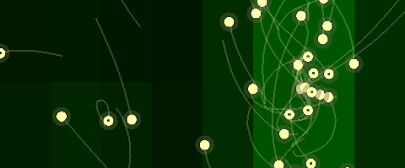Category: Particle Physics Simulator
Bug fixes and more in 3.2.4
New bugfix version of Particle Physics Simulator for Android (v3.2.4)
I just released the new bugfix version (3.2.4) which fixes the following bugs (all of them reported by Keith):
- Repel touches were off in big simulation area mode.
- Zooming multitouch acted as a single touch when first finger was lifted.
- Particles got stuck on wall ends.
- Additionally, the maximum number of walls has been increased from ten to fifteen.
Version 3.2 out now
New feature version (v3.2) of Particle Physics Simulator for Android!
The new feature version 3.2 of the Particle Physics Simulator brings some new exciting features. I’d like to thank Keith for some cool suggestions. Let’s see the new features:
- Tail length can now be set to short, medium and long. A short tail increases performance but ain’t that cool. Useful for slow devices, mostly.
- Static particles can now be created. The shooting button now cycles through particle, antiparticle and static particle. They are displayed with a cross.
- Gravity level can be set now to zero so that the app can now simulate pool-like scenarios (in combination with elastic collisions), which is kind of cool.
- Simulation can be paused using top velocity bar. This may be useful to set up a configuration from scratch without having particles moving around.
- Finally, initial particle sizes can now be set to extra small, small, medium, large and extra large. It may come in handy in tabs with big screens.
Particle Physics Simulator 3.1.4 in action
New video with version 3.1.4
I just made a new video of the newest version of Particle Physics Simulator (3.1.4) in action running on my Motorola Milestone. The phone is kind of old for today’s standards (600 MHz Cortex-A8 CPU,
PowerVR SGX530 GPU, 256MB RAM) but the frame rate is stable at about 30 FPS regardless of the number of particles. I’d say the performance is fine for the first time since the migration to OpenGL ES in v2.0.
Particle Physics Simulator 3.1 just released
New version 3.1 out now

Particle Physics Simulator 3.1
The new version of the Particle Physics Simulator for Android, the version 3.1.2, has just been released to the Android Market. Among the several new features it contains, I’d like to single out the possibility to change the mesh density in the Particle-Mesh mode, and also the option to display the mesh points. Mesh density values range from 0 to 3, being 0 the less dense and 3 the denser. Increasing the mesh density means more mesh points scattered over the simulation area, where actual values of mass density are computed, which leads to a more accurate simulation with the drawback that it is also slower. Feel free to fiddle with the app, setting different mesh densities and observing how particles react to the new values. In the post image are the four mesh densities included in the simulator.
Particle-Mesh force calculator
Particle-Mesh in version 3.0 of Particle Physics Simulator

Particle-mesh in PPS 3.0
The new version 3.0 of the Particle Physics Simulator has been out for almost a month now, but I just had no time to write a post about it. I guess most of you already got the automatic update via the Android Market. The most notorious feature added is the incorporation of a new force calculator method which is selectable from the preferences screen. The force calculator method is the first of two steps in any simplified n-body code, where forces acting on each particle are calculated. Then, the integrator comes in to derive new accelerations, velocities and, ultimately, positions, which are conveniently updated and displayed in screen to create the illusion of a smooth animation.
In the basic direct method each particle’s force is calculated directly applying Newton’s second law of motion, where given initial positions \(q_i\) and velocities \(\dot q_i\) for the \(i\) particles, we can get the forces with:
Particle Physics Simulator videos
Juicy videos of the app running
Here are some videos of the various versions that have been released of the Particle Physics Simulator (formerly called N-Body Simulator) for Android.